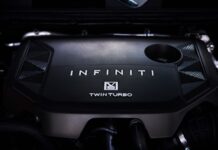
There’s still plenty we don’t know about the 2022 Toyota Tundra, including its powertrain. Of course, rumors have been swirling for months that Toyota’s warhorse of a half-ton truck — the current model has been around for thirteen years now — will lose its current 5.7-liter V8 in favor of a more modern engine. Word has it the new truck will house a twin-turbocharged 3.5-liter V6, or it may have a hybrid powertrain. Some are hopeful it could even have a diesel option, although Toyota has strictly stuck with gasoline engines in the U.S. market for several years.
That said, the newly published patent application below may present another option for the Tundra, at least down the road:

The patent application refers to a “compressed self-ignition” engine
A member of the Rivian Owners Forum, oddly, posted this Toyota patent application to the site. The member says that, “Along with being a fan of Rivian, I’ve been a longtime Toyota fan and have driven my fair share of Tacomas and Tundras.” Last month, Toyota also filed a trademark application for the name “I-Force MAX” for “automobiles and structural parts thereof.”
If what was discovered here comes to fruition, this may flesh out at least some of the technology behind that engine. However, there’s nothing that confirms we’ll see this in the Tundra (or any other near-future Toyota) at the present time. In the documents filed with the U.S. Patent and Trademark Office (USPTO), Toyota mentions a “compressed self-ignition type internal combustion engine” that “includes a heating device for heating at least one of the plurality of ducts (for drawing in fuel)”. Throughout the application, documents describe the various “embodiments” of this engine idea and how the inventors seek to achieve ignition using compression and heat without the fuel-air mixture prematurely detonating inside the combustion chamber.

Some of the terminology in the documents suggest a diesel engine, though the application doesn’t mention the fuel type by name. Further in the “embodiments” and detailed descriptions, Toyota engineers also describe the use of glow plugs as a possible heat source to raise the air temperature to a point that would favor spontaneous compression ignition. That also sounds similar to the homogeneous charge compression ignition (HCCI) technology Mazda is developing in its SkyActiv-X engines — more on that here.
As Mazda and Toyota have been working more closely on ventures these past few years, the latter may be developing its own engine architecture around that concept. There are some disadvantages to using HCCI, including cold start capability and autoignition under certain loads. Mazda in part gets around that issue by using spark plugs, while Toyota may be leaning toward the “heating device” approach to ensure the fuel-air mixture, once its introduced to the cylinder, reaches the right temperature to combust at the right time.
This is the link to the patent application if you’re interested in learning more about it. Particularly for those with deeper engineering backgrounds, let us know what you think about this design idea below. Now, while Toyota filed a patent application back in December, there’s a real possibility this is not the engine a new Tundra will ship with at launch. It may not be an engine for the Tundra at all, as this is just illustrates a concept. However, we’ll see if Toyota brings this idea forward in a new design in the coming months and years. Stay tuned for more updates!
















![Which is More Reliable: 3.5L EcoBoost or 5.0L V8? [Reader Question] Second-generation 3.5-liter EcoBoost engine](https://tfltruck.com/wp-content/uploads/2016/05/Second-generation-35-liter-EcoBoost-engine.jpg)
![Which Silverado Engine to Get: 5.3L or 6.2L V8? [Ask TFLTruck] 2016 chevy silverado](https://tfltruck.com/wp-content/uploads/2015/10/2016-chevy-silverado-grille.jpg)
